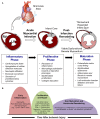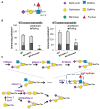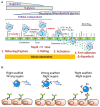Selectins and Immune Cells in Acute Myocardial Infarction and Post-infarction Ventricular Remodeling: Pathophysiology and Novel Treatments
- PMID: 30873166
- PMCID: PMC6400985
- DOI: 10.3389/fimmu.2019.00300
Selectins and Immune Cells in Acute Myocardial Infarction and Post-infarction Ventricular Remodeling: Pathophysiology and Novel Treatments
Abstract
The glycosciences aim to understand the impact of extracellular and intracellular carbohydrate structures on biological function. These glycans primarily fall into three major groups: lipid-linked carbohydrates that are referred to as glycosphingolipids or simply glycolipids; relatively short carbohydrate chains that are often O- or N-linked to proteins yielding common glycoproteins; and extended linear polymeric carbohydrate structures that are referred to as glycosaminoglycans (GAGs). Whereas, the impact of such carbohydrate structures has been extensively examined in cancer biology, their role in acute and chronic heart disease is less studied. In this context, a growing body of evidence indicates that glycans play an important role in immune mediated cell recruitment to damaged heart tissue to initiate wound healing and repair after injury. This is particularly important following ischemia and reperfusion that occurs in the heart in the setting of acute myocardial infarction. Here, immune system-mediated repair of the damaged myocardium plays a critical role in determining post-infarction ventricular remodeling, cardiac function, and patient outcome. Further, alterations in immune cell activity can promote the development of heart failure. The present review summarizes our current understanding of the phases of immune-mediated repair following myocardial infarction. It discusses what is known regarding glycans in mediating the recruitment of circulating immune cells during the early inflammatory stage of post-infarction repair, with focus on the selectin family of adhesion molecules. It offers future directions for research aimed at utilizing our knowledge of mechanisms underlying immune cell recruitment to either modulate leukocyte recruitment to the injured tissue or enhance the targeted delivery of biologic therapeutics such as stem cells in an attempt to promote repair of the damaged heart.
Keywords: glycan; heart disease; leukocyte-endothelial cell adhesion; mesenchymal (stromal) stem cells; myocardial infarction; post-infarct repair; sL; sP-selectin); selectin (sE; stem cells.
Figures



Similar articles
-
The inflammatory response in myocardial infarction.Cardiovasc Res. 2002 Jan;53(1):31-47. doi: 10.1016/s0008-6363(01)00434-5. Cardiovasc Res. 2002. PMID: 11744011 Review.
-
The Regulatory Role of T Cell Responses in Cardiac Remodeling Following Myocardial Infarction.Int J Mol Sci. 2020 Jul 16;21(14):5013. doi: 10.3390/ijms21145013. Int J Mol Sci. 2020. PMID: 32708585 Free PMC article. Review.
-
Post-infarct cardiac injury, protection and repair: roles of non-cardiomyocyte multicellular and acellular components.Sci China Life Sci. 2018 Mar;61(3):266-276. doi: 10.1007/s11427-017-9223-x. Epub 2018 Jan 23. Sci China Life Sci. 2018. PMID: 29388041 Review.
-
Podoplanin neutralization improves cardiac remodeling and function after acute myocardial infarction.JCI Insight. 2019 Jul 9;5(15):e126967. doi: 10.1172/jci.insight.126967. JCI Insight. 2019. PMID: 31287805 Free PMC article.
-
[Soluble selectins in myocardial infarction].Pol Merkur Lekarski. 2013 Apr;34(202):188-91. Pol Merkur Lekarski. 2013. PMID: 23745322 Clinical Trial. Polish.
Cited by
-
Revealing Calcium Signaling Pathway as Novel Mechanism of Danhong Injection for Treating Acute Myocardial Infarction by Systems Pharmacology and Experiment Validation.Front Pharmacol. 2022 Feb 23;13:839936. doi: 10.3389/fphar.2022.839936. eCollection 2022. Front Pharmacol. 2022. PMID: 35281886 Free PMC article.
-
Nanomaterials as Ultrasound Theragnostic Tools for Heart Disease Treatment/Diagnosis.Int J Mol Sci. 2022 Jan 31;23(3):1683. doi: 10.3390/ijms23031683. Int J Mol Sci. 2022. PMID: 35163604 Free PMC article. Review.
-
Neutrophils aid cellular therapeutics by enhancing glycoengineered stem cell recruitment and retention at sites of inflammation.Biomaterials. 2021 Sep;276:121048. doi: 10.1016/j.biomaterials.2021.121048. Epub 2021 Jul 27. Biomaterials. 2021. PMID: 34343858 Free PMC article.
-
Exploring Cardiac Exosomal RNAs of Acute Myocardial Infarction.Biomedicines. 2024 Feb 14;12(2):430. doi: 10.3390/biomedicines12020430. Biomedicines. 2024. PMID: 38398032 Free PMC article.
-
Reproducing extracellular matrix adverse remodelling of non-ST myocardial infarction in a large animal model.Nat Commun. 2023 Feb 22;14(1):995. doi: 10.1038/s41467-023-36350-1. Nat Commun. 2023. PMID: 36813782 Free PMC article.
References
Publication types
MeSH terms
Substances
Grants and funding
LinkOut - more resources
Full Text Sources
Medical

